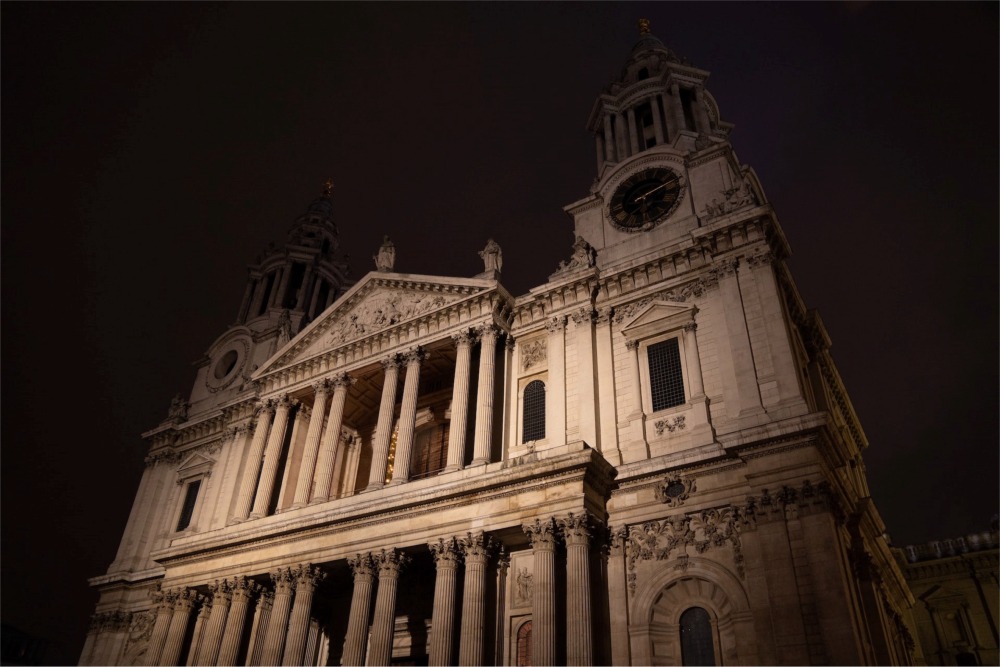St Paul's Cathedral West Facade
Home > Photos from England > St. Pauls Cathedral > St Paul's Cathedral West Facade

This night photograph shows the western facade of St Paul's Cathedral in London England.
Clock and bells
A clock was installed in the southwest tower by Langley Bradley in 1709 but was worn out by the end of the 19th century. The present mechanism was built in 1893 by Smith of Derby incorporating a design of escapement by Edmund Denison Beckett similar to that used by Edward Dent on Big Ben's mechanism in 1895. The clock mechanism is 19 feet (5.8 m) long and is the most recent of the clocks introduced to St Paul's Cathedral over the centuries. Since 1969 the clock has been electrically wound with equipment designed and installed by Smith of Derby, relieving the clock custodian from the work of cranking up the heavy drive weights.
The south-west tower also contains four bells, of which Great Paul, cast in 1881 by J. W. Taylor of Taylor's bell foundry of Loughborough, at 16+1⁄2 long tons (16,800 kg) was the largest bell in the British Isles until the casting of the Olympic Bell for the 2012 London Olympics. Although the bell is traditionally sounded at 1 PM each day, Great Paul had not been rung for several years because of a broken chiming mechanism. In the 1970s, the bolt that held the clapper in place inside the bell had broken. The clapper and its suspension, which together weigh a tonne, had fallen through the clock mechanism below, causing £30,000 worth of damage. In about 1989, the clapper had finally and irrevocably fractured. On 31 July 2021, during the London Festival of the Bells, Great Paul rang for the first time in two decades, being hand swung by the bell ringers. The clock bells included Great Tom, which was moved from St Stephen's Chapel at the Palace of Westminster and has been recast several times, the last time by Richard Phelps. It chimes the hour and is traditionally tolled on occasions of a death in the royal family, the Bishop of London, or the Lord Mayor of London, although an exception was made at the death of the US president James Garfield. It was last tolled for the death of Queen Elizabeth II in 2022, ringing once every minute along with other bells across the country in honor of the 96 years of her life. In 1717, Richard Phelps cast two more bells that were added as "quarter jacks" that ring on the quarter hour. Still in use today, the first weighs 13 long cwt (1,500 lb; 660 kg), is 41 inches (100 cm) in diameter and is tuned to A♭; the second weighs 35 long cwt (3,900 lb; 1,800 kg) and is 58 inches (150 cm) in diameter and is tuned to E♭.
The north-west tower contains a ring of 12 bells by John Taylor & Co of Loughborough hung for change ringing. In January 2018 the bells were removed for refurbishment and were rehung in September that year, being rung again for the first time on All Saints' Day. The original service or "Communion" bell dating from 1700 and known as "the Banger" is rung before 8 am services.
St Paul's Cathedral
St Paul's Cathedral is an Anglican cathedral in London and is the seat of the Bishop of London. The cathedral serves as the mother church of the Diocese of London. It is on Ludgate Hill at the highest point of the City of London and is a Grade I listed building. Its dedication to Paul the Apostle dates back to the original church on this site, founded in AD 604. The present structure, dating from the late 17th century, was designed in the English Baroque style by Sir Christopher Wren. Its construction, completed in Wren's lifetime, was part of a major rebuilding programme in the city after the Great Fire of London. The earlier Gothic cathedral (Old St Paul's Cathedral), largely destroyed in the Great Fire, was a central focus for medieval and early modern London, including Paul's walk and St Paul's Churchyard, being the site of St. Paul's Cross.
The cathedral is one of the most famous and recognisable sights in London. Its dome, surrounded by the spires of Wren's City churches, has dominated the skyline for over 300 years. At 365 ft (111 m) high, it was the tallest building in London from 1710 to 1963. The dome is still one of the highest in the world. St Paul's is the second-largest church building in area in the United Kingdom, after Liverpool Cathedral.
Services held at St Paul's have included the funerals of Admiral Lord Nelson, the Duke of Wellington, Winston Churchill, and Margaret Thatcher; jubilee celebrations for Queen Victoria; an inauguration service for the Metropolitan Hospital Sunday Fund; peace services marking the end of the First and Second World Wars; the wedding of Prince Charles and Lady Diana Spencer; the launch of the Festival of Britain; and the thanksgiving services for the Silver, Golden, Diamond, and Platinum Jubilees and the 80th and 90th birthdays of Queen Elizabeth II. St Paul's Cathedral is the central subject of much promotional material and images of the dome surrounded by the smoke and fire of the Blitz. The cathedral is a working church with hourly prayer and daily services. The tourist entry fee at the door is £21 for adults (Summer 2022, cheaper if booked online), but no charges are made to worshippers attending advertised services.
The nearest underground station is St Paul's, which is 130 yards (120 m) away from St Paul's Cathedral.
From Wikipedia, the free encyclopedia.


